Yackman’s Note: This is a revision of the original Suwannee River Sojourn trip report written in 2009. It has been moved from an obsolete website and reformatted to fit here.

Getting There: March 3 – 6, 2009: I decided to drive to Florida rather than fly on this trip. There were several reasons for this. My buddy, John Resch is from Rochester. I needed to go to Rochester to visit my son who was scheduled for surgery in a few days. John was already in Florida playing golf (a nasty habit!). Since I needed to make the trip to Rochester anyway, I offered to pick up his boat and gear, and haul it to Florida along with my stuff. This would also be the first long road trip with my new car.
Usually we don’t need our boats. Scott has boats that are typically part of the package when we sign on for a guided trip with him. And we could have used his boats this time too. This however, was a different kind of trip. It was an exploratory trip in which Scott would assess the commercial possibilities of the Suwannee River as a site for guided trips. Scott did the planning and we agreed to split all trip costs three ways. John and I were along as (a) companions, (b) guinea pigs, (c) charity cases; I’m not sure, but we were very glad to be included. So we decided to haul our boats to the Suwannee just because we had always wanted to paddle our own boats in Florida.
I was on the road early on March 4th after dropping two of my grand daughters at their Junior/Senior High School. I drove all day (I like to drive) and pulled into a Holiday Inn Express in Huntersville, North Carolina around 8 pm. After dinner and a good night’s sleep, I was on the road again by 8 am. A large cup of McDonald’s gourmet blend coffee rested in my cup holder, sending out wonderful wake-up aromas.
I was making great time. I didn’t need to be at the Suwannee River Valley Campground until early afternoon on March 6th, and it was only March 5th. This gave me some time to look at a few places that Lisa and I could consider if we decide to relocate to the south in the next few years.
My first stop was to be St Mary’s Georgia. St. Mary’s is just north of the Georgia-Florida border, about an hour’s drive from Jacksonville. I got to St. Mary’s about two o’clock and walked around for close to two hours. I checked out the paddling possibilities at the Cumberland Island National Sea Shore (marginal) and stopped by Up-The-Creek Outfitters to say hello. Up-the-Creek is listed on my links page and I wanted to see the operation for myself. I then drove on to Jacksonville, a big city. Making my way to the barrier islands, I followed them south through Jacksonville Beach and Punta Gorda, finally arriving in St. Augustine. I liked St. Augustine. So I grabbed a room at a Days Inn in town and went exploring.
After breakfast next morning I explored some more and bought some gifts for the folks back home. Then I got back on the road, heading north, this time toward Jacksonville where I would turn left for the rural heartland of Florida. The land here was flat, as is all of Florida, but pretty, and sparsely populated. I arrived at the Suwannee Valley Campground, a private KOA facility, at 1:30 pm to find John sitting on the porch of the main building, waiting.

The Suwannee Valley KOA Campground: March 6, 2009: John and I exchanged greetings while he checked to see that his boat had made the trip without mishap. We decided to register and start setting up camp while we waited for Scott, as we still had much to accomplish before dark. The registrar was very helpful. We were happy to find that there were “tent sites” in this campground that largely catered to large RV’s. Directions said, drive into the campground, take a left at the chapel and drive down the road to the tent camping area. John and I headed off in my car but found no chapel or road. On our second swing through the camp, we saw that the chapel was across the road from the main building (we hadn’t started looking for it soon enough) and the road was a barely discernable pathway down a rutted and bumpy hill. After bouncing our way to the bottom, we pulled up next to a pair of picnic tables under big Live Oak trees. This would be our home for the next twenty-four hours.

We were starting to unload our gear when we spotted Scott’s big green van bouncing down the same rutted road we had traveled. After an exchange of greetings, we each picked a spot and set up our tents for the night, and began sorting gear for tomorrow’s launch. It was a pleasant afternoon with time to relax a bit and talk. Around 5 pm, we climbed into John’s car and headed for Live Oak, a nearby town with a Super Wal-Mart and (we hoped) a choice of places to eat.
The Wal-Mart was our first stop as we had agreed to shop for food when we arrived rather than bring stuff from home. Scott and I had discussed some meal possibilities before hand and we were soon locating the things needed to prepare several of our favorites. We also created two new meals on the spot from items we found there (I’ll share the menu with you at a later time). Neither Scott nor I use the prepackaged, freeze-dried camp food that is widely available. We prefer to prepare our own meals from things available in most supermarkets. This is a bit of a challenge as it is very difficult to bring fresh fruits and vegetables on a days-long self-contained kayak trip.
Restaurant possibilities in Live Oak were limited. There was a McDonalds, a Taco Bell and some other fast food places. The only place that began to offer a sit-down meal was a Chinese Buffet. We had a better than expected meal at the buffet and, as is usual with buffets, we all ate too much.
Back at camp, we set about repackaging our food. We save lots of space by removing things from their boxed packages and placing them in ziplock bags. These are then placed in dry bags by meal type – breakfast, lunch and dinner. By the time we finished, it was dark. The crickets were singing and a beautiful full moon in a cloudless sky shown through the leafless trees waiting for spring to nudge them into bloom. After absorbing this beautiful evening for a time, it was off to bed for what we expected would be a cold night.

Suwannee River Valley Campground to Woods Ferry River Camp: March 7, 2009: It was a cold night, with temperatures dipping into the forty’s. I had dressed for the cold, with long underwear, a light polartec sweater and a stocking cap, but still, by 3 am the cold had penetrated my sleeping bag and I was awake. Or half awake anyway. I knew that I had other things I could pull on if I was cold, but I wasn’t that cold, not so cold as to want to unzip my sleeping bag and climb out into the cold night to rummage through a dry bag for ice cold clothing. So I lay there, rolling from my left side to my back and then to my right side, attempting to warm whichever part seemed coldest at the time.
By 6:45 am I’d had enough. It was barely dawn, but I got up anyway and began packing up the gear in my tent. By 7:30, everyone was up. Soon the tents were down and we walked to the river to explore the put-in. It was not a pretty picture. We needed to drop our boats atop a high riverbank and hand carry them down a crude switchback trail to the water. The sand beach below was fairly steep to the water’s edge.
Returning to our cars, we decided to drop our boats and gear on the riverbank near the switchback trail, leaving them while we drove all three cars to Fanning Springs State Park, our end point and pullout. We would leave two cars there and come back in John’s car, which would be left at the KOA while we were on the river. It was a ninety-minute trip each way to drop off the cars. But first, McDonald’s for an Egg McMuffin and a large coffee!
The trip to Fanning Springs was uneventful. No one was at the gatehouse when we arrived. It was unclear where we should park our cars or how much the parking fees would be. While exploring, I ran into the assistant park manager. He was off duty, but was very helpful, providing the correct materials for parking and showing us the canoe launch (which we had missed) and an appropriate parking area for our cars.

Back at the Suwannee Valley KOA, we carried our boats and then our gear from the high riverbank to the beach below. It was treacherous, as the pathway was layered with fallen Live Oak leaves, which are slick as ice. John and I set our boats on the beach parallel to the river. Scott set his boat perpendicular to the river. The reason for the difference soon became apparent. Kneeling on the uphill side to load our boats was clearly a disadvantage for John and I. As we worked, our boats kept slipping sideways in the sand until they  were half in the water. Scott on the other hand, could get to both sides of his boat and could work from downhill, a definite advantage. Experience does make a difference.
were half in the water. Scott on the other hand, could get to both sides of his boat and could work from downhill, a definite advantage. Experience does make a difference.
We launched just before 2:00 pm. The river here is narrow with very porous limestone banks on both sides except where the river turns, and it turns often. There the limestone rises high on the outside of each turn, while beautiful sparkling white sandbars mark the insides. Many paddlers camp on these sandbars north of this section of the river, as they are numerous and are public land. And designated camping areas are few and far between. With so many twists and turns the river is quite beautiful and full of surprises.
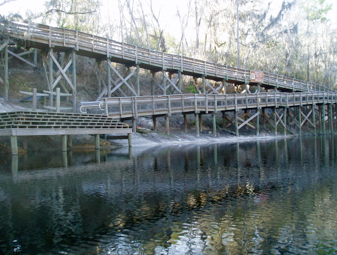
By 4:30 pm. we arrived at our first night’s camping spot – Woods Ferry River Camp. These river camps are being created by the state of Florida as part of their state parks system. They are an integral part of the Suwannee River Wilderness Trail. The only pullout at Woods Ferry was along a narrow sloping sand margin under the access ramp. Each river camp is similar, with five or so camping platforms, a “primitive” tent camping area, a covered pavilion for groups, a campfire circle, and best of all, air conditioned bathrooms with flush toilets and hot showers. Several of the camps even have outside facilities for washing dishes. The camping platforms are roofed and screened covered platforms with ceiling fans, lights and electricity: Pretty plush!

You can reserve a platform in advance, or just show up and take your chances. We did both. And best of all, there is no charge to use these facilities! We expect that there will be a charge imposed when all the camps are completed. (Click here for a video tour of Woods Ferry River Camp)
We were greeted by the Camp Host and told that there was one paddler here using the handicapped unit, with a group of college students, scheduled to arrive any time, needing two units. She suggested we take the farthest unit because of its view and remoteness. We liked the unit and began to settle in as the students and their advisor from Valdosta State University in Georgia arrived.
The students appeared to be pretty new at paddling and camping. Their advisor was in charge of the school’s outdoor education program. His goal was to introduce as many students as possible to many different outdoor activities. The students seemed tired but game. They had paddled the same eleven miles we had, but in much heavier and slower plastic canoes. Soon after arrival they set about making their dinner, but needed to borrow a match to get their stove going.
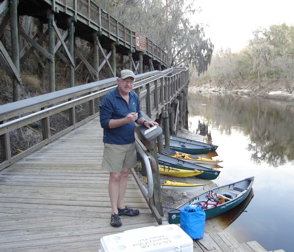
The other camper at Woods Ferry was a single woman named Linda Vanaman. She had paddled a short solo canoe from Fargo , about seventy-miles up stream in Georgia. Her only companion was her dog. Linda had averaged ten or twelve miles per day, camping on sandbars until this night. She was really relishing the luxury of the warm shower at this camp and the ability to wash her hair! Linda would end her trip tomorrow at the Spirit of the Suwannee Music Park a few miles downstream. I was impressed that Linda had done this trip solo. This was the only time we shared a river camp with other paddlers.
Around five o’clock we made dinner. Dark would come early tonight, but tomorrow morning marked the beginning of Eastern Daylight Savings Time. Tonight we would “spring ahead”, pushing sunset back for the rest of the trip, but also delaying sunrise till after 7 am. John, who hadn’t paddled in months, was pooped. He crawled into his sleeping bag as dusk settled around us. Soon the quiet sound of his snoring signaled that he was asleep.

Scott and I stayed up quietly arranging gear, getting things in order for the rest of the trip. We left the overhead light on for a while; it seemed like such a luxury. By the time I got back from brushing my teeth, the overhead light was out and Scott was settled in his sleeping bag reading a book about Napoleon with the light from his headlamp. I found my headlamp, put a few things away, then crawled into my bag to read my book, an odd choice called Stiff: The Curious Lives of Human Cadavers (Click here to view book review). The college students were unexpectedly quiet. Apparently they too were tired and ready to turn in.
As I lay there quietly reading, I felt a cool breeze on my face. Night sounds began to fill the space around our platform. The full moon rose in a clear sky to shine through the trees again. It would be another cold night. Soon my eyes were heavy. I turned off my headlamp and went to sleep.

Woods Ferry River Camp to Holton Creek River Camp: March 8, 2009: It was cold again last night. Not as cold as the night before, but cold enough. And since I didn’t have my tent to trap any body heat, I was rolling around again by three o’clock, trying to stay warm. The night started off pleasant enough. But about by early morning it started to cool down. By five, it was cold. Only the tip of my nose stuck out of my sleeping bag, and it was like ice. Northern Florida in early March is still cold on many nights.

Dawn arrived late, sometime after 7 am. I dragged myself out in the half-light and pulled on several layers of clothing to fight the chill till the sun came up. Then I set to work making coffee. Scott was grinding coffee beans in a small hand grinder. I’m not enough of a purest to want to go to that trouble, so I fired up the Jetboil and used my pre-ground coffee to brew a cup for both John and myself.
We were all moving slowly. I don’t know if it was the changeover to DST, fatigue from the past two days activities, or just that it was Sunday morning, but we took our time with coffee and breakfast, and continued to move slowly as we packed up our gear, trucked it to the beach and loaded our boats.
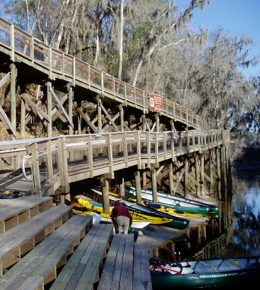
Loading was somewhat difficult as there were many canoes and kayaks crowded up against a wet and slippery embankment, under the ramp that led up to the campground. I was constantly avoiding slips that would set me down on the wet ground, while carrying bags of gear and excusing myself as I stepped over canoes and around canoeists who were also loading their boats. It was 10:30 before we were in out boats and on our way.

The river was especially beautiful on this morning. The sun was throwing light diamonds across our path. They gleamed and danced before us as we paddled south. On every side were eroded limestone formations with the roots of Cypress and Live Oak trees making fantastic patterns on the face of the rocks as they struggled to stay upright and hold on. Sandbars were bigger and more numerous along this stretch of river. Their sand is white, very white, and very fine in texture. They gleam on the inside corner of almost every significant turn of the river. As it was Sunday, many families were enjoying the day fishing, swimming and picnicking on them.

Every now and then we’d get a waif of sulfur. At first we suspected a sewage problem. Then we realized that the river is full of springs. We could see them rising from the bottom on the river’s surface. Some of them were sulfur springs! There was a time when bathing in a sulfur spring was thought to have health benefits – hard to believe now.
We saw a few animals today, mostly birds. There were the stubby winged Kingfishers, a hawk or two, Blue Heron, the ever present Turkey Vultures and Black Buzzards, fish jumping everywhere, including what Scott identified as a Sturgeon, and about a gazillion turtles of all sizes. Every tree that had come to rest in the water had several turtles on it soaking up the warmth, with their legs and neck sticking straight out for maximum sun exposure.
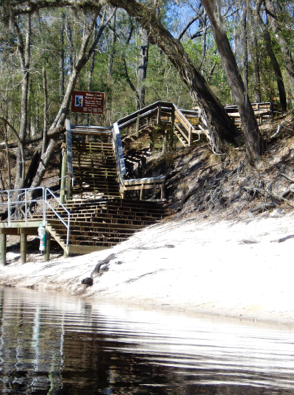
We arrived at Holton Creek River Camp sometime after 4:00 pm. (Click here for a tour of Holton Creek River Camp) The landing here was much better than at Woods Ferry. There was a beach. It was somewhat narrow and inclined, but still serviceable. This camp is similar to the one at Woods Ferry.
We went looking for the Camp Host, but instead found a reserved sign on one of the platforms with our names on it. The host was nowhere to be found, and in fact, never appeared while we were there. We were the only paddlers in camp.
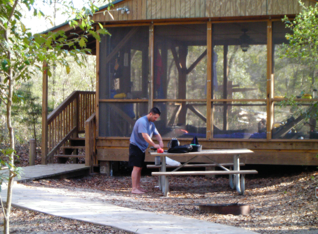
Camp was soon set up and dinner was underway. After dinner, we all wanted showers, so one by one we headed over to the bathhouse to clean up. I was last, finishing after dark and wishing I had taken my headlamp with me. Returning to our camping platform, I heard John’s quiet snoring and saw Scott deep into his book on Napoleon again. Finding my headlamp, I sat at one of the two benches on the platform and made entries in my journal. Suddenly, I became aware of the silence. It was so quiet; a quiet you never experience at home. There was only the soft call of crickets and John’s muted snoring, with the occasional sound of a page being turned, while the full moon shone through the nearly bare branches of the early spring trees.

Holton Creek River Camp to River Camp III: March 9, 2009:
Dawn came late again, with the second day of daylight savings time. What we have gained in the evening, we have given up in the morning. It’s 7:45 and the sun is just barely up. It was cold again too, so no one was eager to crawl out into the morning. But the sky was clear and bright, suggesting that we would have another beautiful day. I pulled long pants over my long johns, and threw on a second layer of polartec before venturing out to make coffee and start breakfast. Even with a late start, we were on the water and underway by 9:30

It was a short paddle to our next scheduled camp, Suwannee River State Park. We had fussed about this short paddle because of the several long days that followed it. We knew that there were no designated camping areas on the map at twenty miles or so from Holton Creek. Suwannee River State Park was it until Lafayette Blue Springs River Camp, about thirty miles from Holton Creek. Never-the-less, we decided to by-pass Suwannee River State Park and take a chance on finding a good sandbar or other suitable location to camp on when we had paddled about twenty miles.
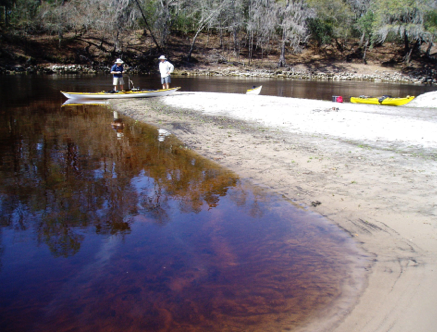
Lunch break on a typical Suwannee River sandbar.
The river appeared much the same as on the previous days. We arrived at Suwannee River State Park about 1:30, took a look at the landing and paddled on. The river began to change below the state park. It became wider with fewer twists and turns. As a result, there were fewer and fewer large sandbars. We passed through a section with many more private river camps. These were camps in the old sense of the word. They were small, rustic getaways, not second homes or McMansions.

After passing the Withlacoochee River where it joins the Suwannee, the current picked up and we made really good time, averaging about 5 mph. When we had paddled twenty-two miles, we began to look for a camping spot. It wasn’t easy, as the sandbars we had counted on had all but disappeared. We scanned both riverbanks for over a mile, checking and rejecting several spots as too wet, too small, too buggy, etc. Finally we spotted a shattered boat ramp with nothing else around it. On closer inspection we saw an old picnic table and a trash barrel, all in various states of decay. Going ashore, we noticed several grassy roads heading into the woods in several directions, most of them blocked by a deliberately fallen tree or a cable.

There was an open flat area suitable for our tents and a broken picnic table on which to cook dinner. Scott and I walked up what seemed to be a main road looking for some sign of civilization – a house, a highway or a human being. We were looking to ask permission to camp for the night. We found nothing to tell us where we were, who owned the land or if it was restricted in any way. After a mile or so, we turned around and headed back. We no sooner had out tents set up and were beginning dinner, when a truck came down the “main” road, passed by us, and stopped at the top of the remnants of the boat ramp. A man got out, walked to the water’s edge and scanned the river for some time. I walked over and explained what we were doing, and asked if it was OK for us to be camped here. He said that the land was a state forest and that there was no one around for miles, but that he guessed it was OK as this was public land. (After studying several maps, I now believe that we were in the Twin Rivers State Forest.)

Scott and I cooked tortellini tonight. I was really good. John cleaned up, then we all sat around and talked quietly as the sun went down and dusk settled around us.
A Barred Owl gave a loud and startling cry very close by, which seemed to signal the mosquitoes to come out. These mosquitoes are different from northern mosquitoes. They are black and about a third the size. I seldom felt a bite, and they didn’t itch much at first. But the bites persisted for weeks, some of them becoming quite itchy. Even though it was not yet dark, we went to our tents to escape the little buggers.
I wasn’t tired, so I sat in my Crazy Creek chair, made notes in my journal about the day and read from my book. Tonight’s chapter is entitled “Dead Man Driving: Human Crash Test Dummies and the Ghastly, Necessary Science of Impact Tolerance”. Why am I reading this book?
